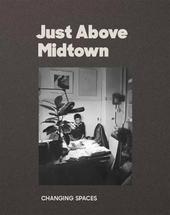
|
Just Above Midtown: 1974 to the Present
Paperback / softback
Main Details
| Title |
Just Above Midtown: 1974 to the Present
|
| Authors and Contributors |
Edited by Thomas J. Lax
|
|
Edited by Lilia Rocio Taboada
|
|
Text by Kellie Jones
|
|
Text by Rujeko Hockley
|
|
Text by Eric Booker
|
| Physical Properties |
| Format:Paperback / softback | | Pages:184 | | Dimensions(mm): Height 305,Width 240 |
|
| Category/Genre | Exhibition catalogues and specific collections |
|---|
| ISBN/Barcode |
9781633451377
|
| Classifications | Dewey:704.0396073 |
|---|
| Audience | |
|---|
| Illustrations |
200 Illustrations, unspecified
|
|
Publishing Details |
| Publisher |
Museum of Modern Art
|
| Imprint |
Museum of Modern Art
|
| Publication Date |
20 October 2022 |
| Publication Country |
United States
|
Description
Just Above Midtown, or JAM, was an art gallery and self-described laboratory led by Linda Goode Bryant that foregrounded African American artists and artists of color. Open from 1974 until 1986, it was a place where black art flourished and debate was cultivated. The gallery offered early opportunities for artists now recognized as pivotal figures in late-20th-century art, including David Hammons, Butch Morris, Senga Nengudi, Lorraine O'Grady, and Howardena Pindell. Published in conjunction with the first museum exhibition to focus on this extraordinary gallery, on view at The Museum of Modern Art, New York, in Fall 2022, Just Above Midtown: 1974 to the Present showcases rarely seen material from the JAM archive of artworks, ephemera, and unique documentation of administrative and programmatic activities. The richly illustrated catalogue includes a conversation between Thelma Golden, Director and Chief Curator of The Studio Museum in Harlem, and Linda Goode Bryant, a complete exhibition chronology with nearly 50 annotated entries, and excerpts from an oral history of JAM.
Author Biography
Thomas J. Lax is a Curator in the Department of Media and Performance, The Museum of Modern Art, New York. Lilia Rocio Taboada is a Curatorial Assistant in the Department of Media and Performance, MoMA. Linda Goode Bryant is the founder of Just Above Midtown (JAM). Thelma Golden is the Director and Chief Curator of The Studio Museum in Harlem. Kellie Jones is Professor in Art History and Archaeology and the Institute for Research in African American Studies (IRAAS) at Columbia University. Rujeko Hockley is an Assistant Curator at the Whitney Museum of American Art. Eric Booker is an Assistant Curator and Exhibition Coordinator at The Studio Museum in Harlem. Brandon Eng is the 2021-22 Mellon-Marron Research Consortium Fellow in the Department of Media and Performance, MoMA. Marielle Ingram was the 2019-20 12-Month Intern in the Department of Media and Performance, MoMA. Yelena Keller is a Curatorial Assistant, Exhibitions, at The Studio Museum in Harlem. Legacy Russell is the Executive Director and Chief Curator of The Kitchen, and previously an Associate Curator, Exhibitions, at The Studio Museum in Harlem.
ReviewsA well-researched resource on the institution that reprints all the archival materials, and includes quotes from curators, artists, and historians.--Megan Liberty "Brooklyn Rail" Bryant stuck to her guns, convinced New York artists could use a look at work that pushed beyond Western abstraction and expanded notions of what could be considered art materials.--Stephanie Eckardt "W Magazine" In the catalogue, there are wonderful photographs of Black powerhouses like Stevie Wonder and Roberta Flack (who funded a show at jam) stopping by the gallery to commune with the work.--Hilton Als "New Yorker" The book captures the JAM vibe, and its lead essay by Thomas (T.) Jean Lax, one of the MoMA show's curators, that gets my vote as best of the year.--Holland Cotter "New York Times: Arts" The gallery ethos recognised its divergence from the art industry, embraced collectivism and improvisation, and, of course, provided the space and time needed to create something sweet and delicious.--Anisa Tavangar "Art Newspaper" JAM was a feeling of possibility more than it was a destination and an incentive to experiment more than a platform to sell work. It was an artistic community where process trumped product and mutual aid replaced capital with a barter system of creative exchange and healthy debate.--Cassidy George "New York Magazine: The Cut" Promises to expand our understanding of art history and actually succeeds in doing so.--Alex Greenberger "ARTnews" Provide[s] a venue for Black artists to show at a level of visibility readily available to their white peers, and allowed them to pursue work in whatever medium and mode suited them.-- "NPR: WNYC" Remarkable for its ability to capture and redistribute a spirit of rebellion--the ethos that drove Bryant and others to make and give space to art that resisted market and institutional trends.--Ayanna Dozier "Artsy" The significance of doing a show at MoMA--which, although nearby, might as well have been miles away from JAM when it was operating--proved compelling.--Folasade Ologundudu "Artnet" What resulted from this artist-first mission was some of the most notable avant-garde art of the 20th century.--Nina Raemont "Smithsonian" Bryant understood that the urge to creativity was real; that an indispensable condition for nurture is generosity; and that generosity is a practice of interdependence -- an energy exchange from which all parties profit. MoMA's scrappy, artful document of a show is a salute to that idea, one that honors a past and encourages a when-in-doubt-do-it future.--Holland Cotter "New York Times: Arts" The process of creating the exhibition has been one of Goode Bryant constantly pushing the museum to work differently and the museum finding creative ways to support JAM's values and its artists. That desire to transform what is into what could be is intrinsic to her way of working.--Aruna D'Souza "New York Times: Arts" What set JAM apart, though, wasn't just the gale-force talent that blew through the gallery; it was the way so many of the people connected to it seemed to view art as an exquisitely jagged, intensely personal, inherently social part of life.--Stephen Mooallem "Harper's Bazaar"
|